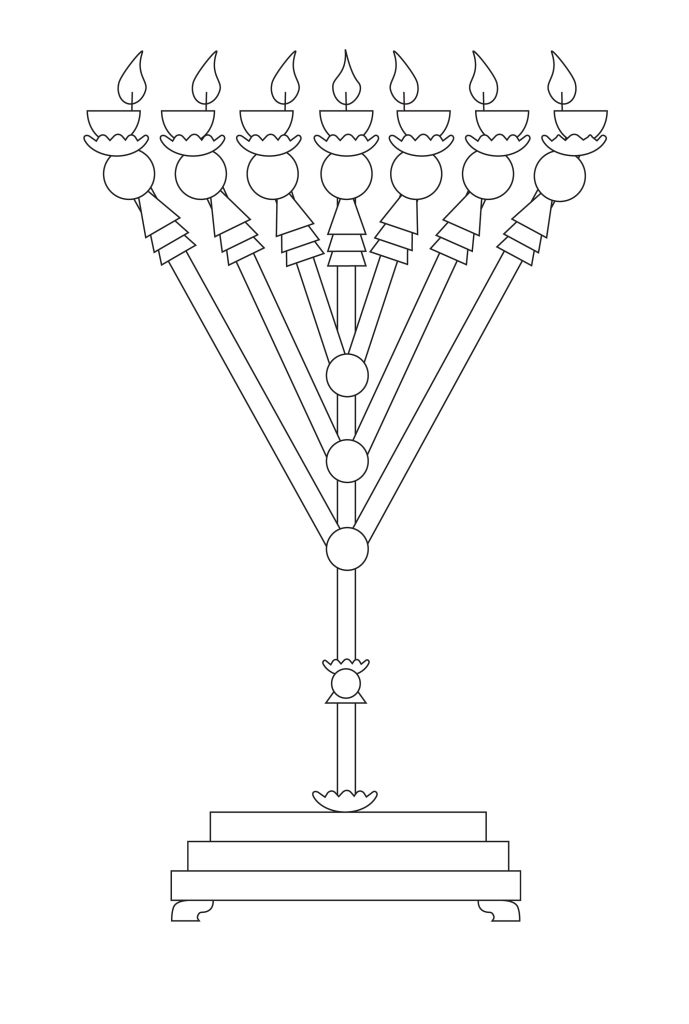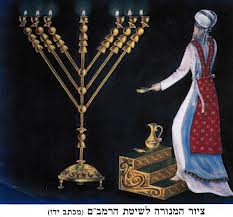The Lord spoke to Moses, saying: “Speak to Aaron and say to him: ‘When you light the lamps, the seven lamps shall cast their light toward the face of the menorah.’”
Numbers 8:1,2
The Torah describes the Menorah, a seven-branched candelabrum, as a sacred object used in the Mishkan (Tabernacle) and later Bet HaMikdash (the Temple in Jerusalem). The Menorah holds deep symbolic meaning.
The Torah has already described in detail the shape of the Menorah in the Book of Exodus. Here, in the Torah portion of Behaalotecha, G‑d instructs Aaron, the High Priest (Kohen Gadol), on how to light the Menorah. These instructions are rather peculiar—what does it mean that “the seven lamps shall cast their light toward the face of the menorah”? The Talmud explains, “Toward the face of the menorah [means] toward the middle lamp.” (Manachot, 98b). Midrash provides further details, “The six on the six branches; the three eastern ones—that is their wicks—facing towards the center one, and likewise, the three western ones, the tops of their wicks facing toward the center one.”

What is the meaning of the seven-branch Menorah, and what is the symbolism of the wicks of the exterior lamps being bent toward the center lamp?
Kabbalah and the Chasidic philosophy of Chabad teach that seven branches of the Menorah represent seven midot—seven lower sefirot: Ḥesed, Gevurah, Tiferet, Netzaḥ, Hod, Yesod, Malḥut. One way to interpret these six midot (lit. “six measures”) is to map them onto six directions of our three-dimensional physical space. Indeed, according to one of the oldest books of Kabbalah, Sefer Yetzirah, the six midot—Ḥesed, Gevurah, Tiferet, Netzaḥ, Hod, and Yesod—are six directions in a three-dimensional space:[1]
A depth of above, a depth of below;
Sefer Yetzirah 1:5
A depth of east, a depth of west;
A depth of north, a depth of south.
Each dimension in space gives us one degree of freedom to move in alternative directions: up or down, right or left, front or back. Thus, six midot construct a three-dimensional space in which we move.
Another way to interpret six midot is to map them on six dimensions of the phase space. Phase space is an abstract space in which every degree of freedom represents two dimensions—one for the value of that degree of freedom and one for the rate of change on that value over time. Configurational space reflects the positions of all particles in the Euclidean space. However, as we know from Newtonian mechanics, to describe the dynamics of the system, we also need to know the momentum of each particle. Each point of the phase space is a pair of vectors—one for the position of each particle and one for the momentum.[2]
So, either approach interprets the six outer branches of the Menorah that symbolize six midot as degrees of freedom associated with movement in the physical space. But what about the middle branch?
Seven branches of the Menorah also correspond to seven days of the week—six outer branches represent six weekdays, and the middle branch represents the Shabbat. As I discussed at length in my essay “Passover, Shabbat and the Principle of Least Action,” Shabbat is the day on which G‑d celebrates achieving His Purpose. Thus, the middle branch represents the Purpose.
Now, we can understand the symbolism of the instruction given to Aaron HaKohen in the Torah portion of Behaalotecha—to bend the wicks of the outer lams toward the middle lamp. The outer lamps of the Menorah represent actions, and the center lamp represents the Purpose. Bending and directing the lights of the outer lamps toward the center lamp teaches us that all our actions must be directed toward the Purpose.
Purposeful behavior is an overarching principle of life. Unlike passive inanimate matter that only moves when it is acted upon by external forces and has no purpose of its onw, live matter is purposeful through and through. Every living cell acts towards the goals encoded in its DNA: to survive, to grow, to maintain internal homeostasis (by reducing the entropy inside the cell at the expense of increasing the entropy outside), and to propagate while replicating its genetic code. This teleological behavior is unique to live matter. In this sense, the Menorah represents the overarching principle of life—purposeful behavior. The Temple Menorah served as a lighthouse, illuminating darkness and providing purpose and direction.
May our lives be purposeful and filled with light.
Endnotes:
[1] English translation by Rabbi Aryeh Kaplan, Sefer Yetzirah (Samuel Weiser, 1990), 44.
[2] Think of phase space as a special kind of map or graph that helps us understand how things move in physics, especially when we are dealing with complicated systems. In Hamiltonian dynamics, we are interested in two main things about an object: (1) its position and (2) its momentum (which is related to its velocity). The phase space is a way to represent both of these things at once. Imagine a graph where the horizontal axis shows the position of an object and the vertical axis shows the momentum (velocity times mass) of the object. Every point on this graph represents a possible state of the system. The coordinates of the point tell us where the object is (its position), how fast it is moving, and in what direction (its momentum). As the object moves and changes over time, it traces out a path in this phase space. This path shows you how both the position and momentum of the object change together. The cool thing about phase space is that it gives us a complete picture of the system at any moment. By looking at a single point in phase space, we can know everything about where an object is and how it is moving. This is particularly useful in Hamiltonian dynamics because the laws of physics in this framework can be written very elegantly in terms of this phase space. It also helps us visualize and understand complex motions that might be hard to grasp otherwise. Phase space is a powerful tool for predicting how systems will evolve over time. Six midot could be mapped onto six dimensions of the phase space with essentially the same result as in the first interpretation—they provide the framework for the freedom of movement in space.
